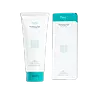What's inside
What's inside
 Key Ingredients
Key Ingredients

 Benefits
Benefits

 Concerns
Concerns

 Ingredients Side-by-side
Ingredients Side-by-side

Water
Skin ConditioningDisodium 2-Sulfolaurate
CleansingCoco-Glucoside
CleansingLauryl Glucoside
CleansingGlycerin
HumectantSucrose Cocoate
EmulsifyingCocamidopropyl Betaine
CleansingCitric Acid
BufferingEthylhexylglycerin
Skin ConditioningTriethyl Citrate
MaskingXanthan Gum
EmulsifyingGlyceryl Laurate
EmollientGlyceryl Caprylate
EmollientGellan Gum
Sodium Chloride
MaskingPanthenol
Skin ConditioningAcacia Senegal Gum
MaskingSalicylic Acid
MaskingBenzoic Acid
MaskingAloe Barbadensis Leaf Juice Powder
Skin ConditioningChondrus Crispus Extract
Skin ConditioningSodium Benzoate
MaskingWater, Disodium 2-Sulfolaurate, Coco-Glucoside, Lauryl Glucoside, Glycerin, Sucrose Cocoate, Cocamidopropyl Betaine, Citric Acid, Ethylhexylglycerin, Triethyl Citrate, Xanthan Gum, Glyceryl Laurate, Glyceryl Caprylate, Gellan Gum, Sodium Chloride, Panthenol, Acacia Senegal Gum, Salicylic Acid, Benzoic Acid, Aloe Barbadensis Leaf Juice Powder, Chondrus Crispus Extract, Sodium Benzoate
Water
Skin ConditioningDecyl Glucoside
CleansingPentylene Glycol
Skin ConditioningMaltooligosyl Glucoside
Skin ConditioningSalicylic Acid
MaskingGlycerin
HumectantHydrogenated Starch Hydrolysate
HumectantCocamidopropyl Betaine
CleansingCopper Gluconate
Skin ConditioningMagnesium Aspartate
Skin ConditioningZinc Gluconate
Skin ConditioningSodium Chloride
MaskingSucrose
HumectantSodium Lauroyl Oat Amino Acids
CleansingCeratonia Siliqua Gum
EmollientChondrus Crispus Extract
Skin ConditioningCellulose Gum
Emulsion StabilisingWater, Decyl Glucoside, Pentylene Glycol, Maltooligosyl Glucoside, Salicylic Acid, Glycerin, Hydrogenated Starch Hydrolysate, Cocamidopropyl Betaine, Copper Gluconate, Magnesium Aspartate, Zinc Gluconate, Sodium Chloride, Sucrose, Sodium Lauroyl Oat Amino Acids, Ceratonia Siliqua Gum, Chondrus Crispus Extract, Cellulose Gum
 Reviews
Reviews

Ingredients Explained
These ingredients are found in both products.
Ingredients higher up in an ingredient list are typically present in a larger amount.
Chondrus Crispus Extract comes from a red algae native to the northern Atlantic coasts of Europe and North America. It helps hydrate the skin and is rich in antioxidants.
The antioxidants in chondrus crispus include lutein and zeaxanthin. Lutein has the ability to filter blue light from screens.
Other contents of chondrus crispus include polysaccharides, peptides, and amino acids. These help hydrate the skin.
What's the difference between algae and seaweed?
Algae is a broad term that includes seaweed. Not all algae is seaweed.
Cocamidopropyl Betaine is a fatty acid created by mixing similar compounds in coconut oil and dimethylaminopropylamine, a compound with two amino groups.
This ingredient is a surfactant and cleanser. It helps gather the dirt, pollutants, and other impurities in your skin to be washed away. It also helps thicken a product and make the texture more creamy.
Being created from coconut oil means Cocamidopropyl Betaine is hydrating for the skin.
While Cocamidopropyl Betaine was believed to be an allergen, a study from 2012 disproved this. It found two compounds in unpure Cocamidopropyl Betaine to be the irritants: aminoamide and 3-dimethylaminopropylamine. High-grade and pure Cocamidopropyl Betaine did not induce allergic reactions during this study.
Learn more about Cocamidopropyl BetaineGlycerin is already naturally found in your skin. It helps moisturize and protect your skin.
A study from 2016 found glycerin to be more effective as a humectant than AHAs and hyaluronic acid.
As a humectant, it helps the skin stay hydrated by pulling moisture to your skin. The low molecular weight of glycerin allows it to pull moisture into the deeper layers of your skin.
Hydrated skin improves your skin barrier; Your skin barrier helps protect against irritants and bacteria.
Glycerin has also been found to have antimicrobial and antiviral properties. Due to these properties, glycerin is often used in wound and burn treatments.
In cosmetics, glycerin is usually derived from plants such as soybean or palm. However, it can also be sourced from animals, such as tallow or animal fat.
This ingredient is organic, colorless, odorless, and non-toxic.
Glycerin is the name for this ingredient in American English. British English uses Glycerol/Glycerine.
Learn more about GlycerinSalicylic Acid (also known as beta hydroxy acid or BHA) is a well-known ingredient for treating skin that struggles with acne and clogged pores. It exfoliates both the skin's surface and deep within the pores to help clear out buildup, control oil, and reduce inflammation.
Unlike AHAs (alpha hydroxy acids), salicylic acid is oil-soluble. This allows it to penetrate into pores which makes it especially effective for treating blackheads and preventing future breakouts.
Salicylic acid is also known for its soothing properties. It has a similar structure to aspirin and can calm inflamed or irritated skin, making it a good option for acne-prone skin that is also sensitive.
Concentrations of 0.5-2% are recognized by the U.S. FDA as an over-the-counter topical acne product.
It can cause irritation and/or dryness if one's skin already has a compromised moisture barrier, so it's best to focus on repairing that before introducing this ingredient into your routine.
While salicylic acid does not increase sun sensitivity, it’s still important to wear sunscreen daily to protect your skin.
If you are looking for the ingredient called BHA or Butylated Hydroxyanisole, click here.
Learn more about Salicylic AcidChances are, you eat sodium chloride every day. Sodium Chloride is also known as table salt.
This ingredient has many purposes in skincare: thickener, emulsifier, and exfoliator.
You'll most likely find this ingredient in cleansers where it is used to create a gel-like texture. As an emulsifier, it also prevents ingredients from separating.
There is much debate on whether this ingredient is comedogenic. The short answer - comedogenic ratings don't tell the whole story. Learn more about comegodenic ratings here.
The concensus about this ingredient causing acne seems to be divided. Research is needed to understand if this ingredient does cause acne.
Scrubs may use salt as the primary exfoliating ingredient.
Learn more about Sodium ChlorideWater. It's the most common cosmetic ingredient of all. You'll usually see it at the top of ingredient lists, meaning that it makes up the largest part of the product.
So why is it so popular? Water most often acts as a solvent - this means that it helps dissolve other ingredients into the formulation.
You'll also recognize water as that liquid we all need to stay alive. If you see this, drink a glass of water. Stay hydrated!
Learn more about Water